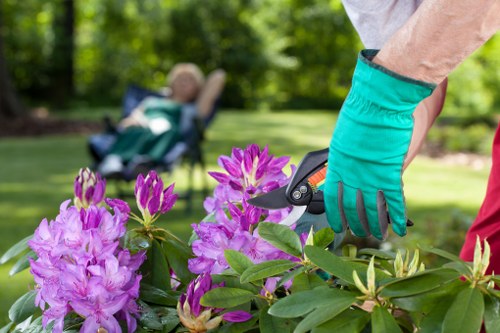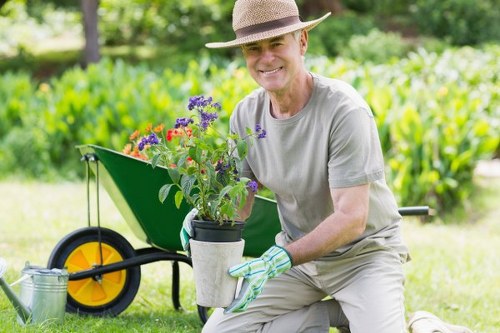Comprehensive Guide to Garden Maintenance in Hornsey

Maintaining a beautiful garden in Hornsey requires a blend of passion, knowledge, and regular care. Whether you’re a seasoned gardener or a novice, understanding the unique climate and soil conditions of Hornsey is crucial for successful garden maintenance.
Hornsey’s climate is characterized by mild winters and warm summers, making it suitable for a wide variety of plants. However, the urban setting can influence factors such as soil quality and sunlight exposure, which are essential considerations for effective garden care.
Proper garden maintenance not only enhances the aesthetic appeal of your outdoor space but also promotes a healthy ecosystem. From selecting the right plants to regular pruning and pest control, each aspect plays a vital role in sustaining a vibrant garden.
Understanding Hornsey’s Soil and Climate

The foundation of any thriving garden is healthy soil. In Hornsey, the soil composition varies, but it generally leans towards clayey soils rich in nutrients. Conducting a soil test can help determine the pH levels and nutrient content, allowing gardeners to make informed decisions about soil amendments.
Hornsey’s microclimates also influence plant growth. Areas with more shade require plants that thrive in low-light conditions, while sunnier spots can accommodate sun-loving species. Understanding these microclimates enables gardeners to optimize plant placement for maximum growth and health.
Rainfall in Hornsey is evenly distributed throughout the year, but summers can be drier. Implementing an efficient irrigation system, such as drip irrigation, ensures that plants receive adequate water without wastage, especially during the hotter months.
Seasonal Garden Maintenance Tips

Adapting garden maintenance practices to the changing seasons is essential for sustained plant health. Each season brings its own set of tasks that contribute to the overall vitality of the garden.
Spring Maintenance
Spring is the perfect time to prepare your garden for the growing season. Start by clearing any debris from the winter months, pruning dead branches, and fertilizing the soil. Planting early spring blooms can add vibrant colors to your garden as the weather warms up.
Summer Care
During summer, focus on watering, weeding, and pest control. Regularly check for signs of drought stress and adjust your watering schedule accordingly. Mulching can help retain soil moisture and suppress weed growth, reducing the maintenance workload.
Autumn Preparations
Autumn is ideal for planting perennials and bulbs that will bloom in the spring. Rake fallen leaves to prevent them from smothering your plants and consider planting cover crops to enrich the soil for the next planting season.
Essential Tools for Garden Maintenance

Having the right tools is indispensable for efficient garden maintenance. Investing in quality tools can make tasks easier and prolong their lifespan.
- Pruning Shears: Essential for trimming and shaping plants.
- Garden Fork: Useful for turning soil and aerating the ground.
- Watering Can or Hose: Crucial for providing plants with adequate water.
- Wheelbarrow: Helps in transporting soil, plants, and debris.
- Gloves: Protect your hands from thorns, splinters, and dirt.
Regular maintenance of these tools, such as cleaning and sharpening, ensures they remain effective and safe to use throughout the gardening season.
Additionally, ergonomic tools can reduce strain on your body, making long hours of gardening more comfortable and enjoyable.
Choosing the Right Plants for Hornsey

Selecting plants that are well-suited to Hornsey’s environment is key to a thriving garden. Consider factors like sunlight, soil type, and water availability when choosing your plants.
Native Plants: Incorporating native species can enhance biodiversity and require less maintenance as they are adapted to the local climate and soil conditions.
Consider also the maintenance requirements of each plant. Some may require regular pruning or specific soil conditions, while others are more resilient and easier to care for.
Flowering Plants
Flowers add color and vibrancy to your garden. Opt for a mix of annuals and perennials to ensure continuous blooms throughout the seasons.
Vegetable Gardens
Growing your own vegetables is not only rewarding but also promotes a sustainable lifestyle. Ensure you have ample sunlight and rich soil to maximize your harvest.
Ornamental Trees and Shrubs
Ornamental trees and shrubs provide structure and can serve as focal points in your garden design. They also offer habitat and food for local wildlife.
Pest and Disease Management
Protecting your garden from pests and diseases is crucial for maintaining plant health. Early detection and intervention can prevent minor issues from escalating into major problems.
Implementing integrated pest management (IPM) strategies, such as introducing beneficial insects and using organic pesticides, can effectively control pest populations without harming the environment.
Regularly inspect your plants for signs of disease, such as discoloration or wilting, and take appropriate measures to address any issues promptly.
Sustainable Garden Practices
Adopting sustainable practices not only benefits your garden but also contributes to environmental conservation. Sustainable gardening minimizes waste, conserves water, and promotes biodiversity.
Composting: Recycling kitchen scraps and garden waste through composting enriches your soil naturally, reducing the need for chemical fertilizers.
Rainwater Harvesting: Collecting rainwater for irrigation can significantly reduce your water usage and lower utility bills.
Mulching
Mulching helps retain soil moisture, suppress weeds, and regulate soil temperature. Organic mulches, like bark or straw, also improve soil structure as they decompose.
Companion Planting
Companion planting involves growing compatible plants together to enhance growth, repel pests, and improve overall garden health.
Hiring Professional Garden Maintenance Services
While DIY garden maintenance can be fulfilling, there are times when hiring professional services can make a significant difference. Professional gardeners bring expertise, experience, and specialized equipment to ensure your garden remains in top condition.
Benefits of Professional Services:
- Expertise: Professionals understand the local climate and soil conditions, allowing them to make informed decisions about plant care and garden design.
- Time-Saving: Hiring experts frees up your time, enabling you to enjoy your garden without the stress of constant upkeep.
- Quality Results: With their skills and tools, professionals can achieve a level of maintenance and aesthetics that might be challenging to attain on your own.
Consider reaching out to local garden maintenance companies in Hornsey to discuss your specific needs and get personalized solutions.
Contact us today to schedule a consultation and let our experts transform your garden into a stunning oasis.
DIY Garden Maintenance Tips
For those who prefer a hands-on approach, here are some practical tips for maintaining your garden in Hornsey:
- Regular Weeding: Keep your garden free from weeds to prevent competition for nutrients and water.
- Pruning: Trim overgrown branches to promote healthy growth and improve plant shape.
- Soil Care: Amend your soil with compost or organic matter to enhance fertility and structure.
- Mulching: Apply mulch to conserve moisture and suppress weed growth.
- Pest Monitoring: Keep an eye out for pests and take immediate action if you notice any infestations.
Implementing these practices consistently can lead to a flourishing garden that thrives throughout the year.
Book your service now to receive more personalized DIY tips and ensure your garden remains vibrant and healthy.
Conclusion
Garden maintenance in Hornsey is a rewarding endeavor that enhances the beauty of your outdoor space and contributes to your overall well-being. By understanding the local climate, selecting appropriate plants, and implementing regular maintenance practices, you can cultivate a garden that thrives year-round.
Whether you choose to maintain your garden yourself or seek professional assistance, the key is consistency and attention to detail. Embrace sustainable practices to not only improve your garden’s health but also support the surrounding ecosystem.
Start your garden maintenance journey today and enjoy the myriad benefits of a well-kept garden in Hornsey.
Contact us today to learn more about our garden maintenance services and take the first step towards a stunning garden.

